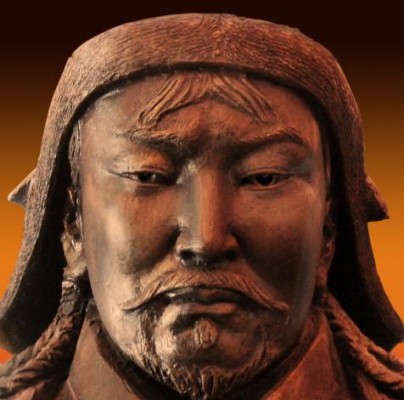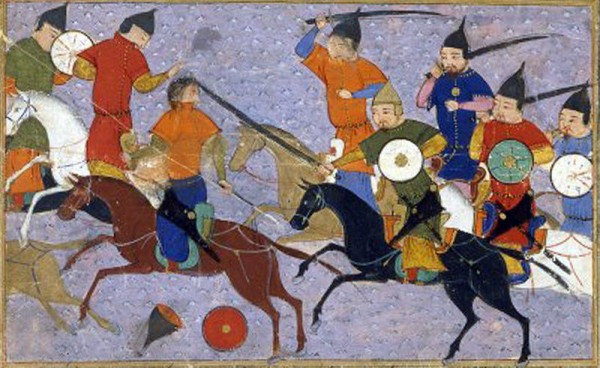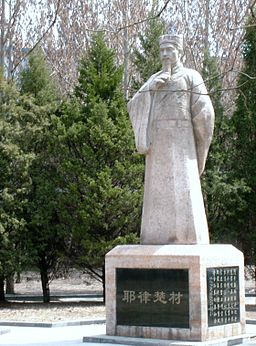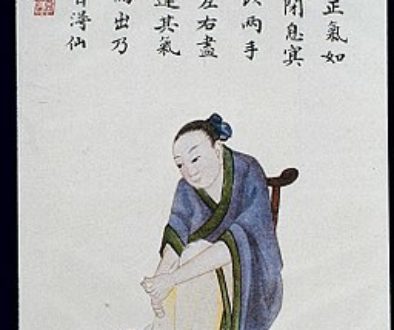Mediating with Genghis Khan: On Working with Difficult People (Yeh-Lu Ch’u Tsai; Yelu Chucai)

This post is a tribute to Yeh-Lu Ch’u Tsai, also known as Yelu Chucai (1190-1240), a man whose work with difficult people, including Genghis Khan, prevented mass genocide in Northern China. Yeh-Lu Ch’u Tsai was able to be effective because
- He gained Genghis Khan’s trust because of his own integrity and loyalty; and
- He presented rigorous well thought out analyses of the benefits to the Mongols of discontinuing the practice of genocide.
From his life we learn that when working with difficult people one must try to simultaneously
- Maintain one’s own spiritual integrity and presence. This is one’s main “calling card” with even the most difficult people;
- Continue to try to meet others, even difficult people, on that level, while recognizing their own integrity and being. This is commonly known as respect.*
- At the same time, never forget, realistically, who they are and what they want on an ego or self-centered level.
For people dealing with powerful people, and high-stakes conflict, forgetting any one of these steps can have disastrous results. And they all must occur simultaneously. (See also this article.) Here are some highlights of Yeh-Lu Ch’u Tsai’s life.
The Sacking of Beijing
In 1214, after a long war, Genghis Khan sacked the city of Zhongdu (now Beijing). Thousands of people were killed and much of the City was demolished by fire.

Yeh-Lu Ch’u Tsai, then a Confucian governmental official, witnessed the carnage. Deeply troubled by what he saw, he became a lay disciple of Wan-Sung, a man recognized as one of the leading Chan Buddhist teachers of the time.
After three years, Yeh-Lu Ch’u Tsai was said to have attained enlightenment. He was recognized by his teacher, who conferred on him the “seal of discipleship.”
Shortly thereafter, he was summoned by Genghis Khan.
The First Meeting with Genghis Khan
At their first meeting, Genghis Khan reminded Yeh-Lu Ch’u Tsai that, although he was sincized, he was not in fact a Chin, but was instead a member of the royal family of a clan which had battled with the Chin. He appealed to what he assumed would be Yeh-Lu Ch’u Tsai’s ethnic hatred of the Chin by saying:
“I have taken revenge for you.”
Yeh-Lu Ch’u Tsai gave a quintessential Confucian reply:
“My father and grandfather have both served the Jin respectfully. How can I, as a subject and a son, be so insincere at heart as to consider my sovereign and my father as enemies?”
In so doing, he honored his father and his grandfather (who had both served in the Chin dynasty) and his ruler, Genghis himself. However, he specifically declined to treat the Chin as his enemy. He also refused to bond with Genghis Khan on the level of hatred alone.
Genghis Khan was impressed, gave him the nickname “Long Beard” and placed him in his retinue.
Work for Genghis Khan
Yeh-Lu Ch’u Tsai became Genghis Khan’s scribe-secretary. He was, effectively, Genghis Khan’s lawyer, in charge of translating and drafting documents in Chinese. Due to his unique background, as noted by de Rachewiltz, he became, in effect, a mediator between the Mongol and Chinese civilizations. He also practiced divination and astrology for the Khan.
At one point, he is said to have caused the withdrawal of the Mongol army from India by interpreting an omen — an apparition of a unicorn — that had supposedly been seen by one of Genghis’ bodyguards. He interpreted the omen as a warning to the Khan to prevent further killing.*
Mistakes and Regrets
Although he considered himself a Confucian and a Buddhist, Yeh-lu Ch’u Tsai hoped that Genghis Khan would be persuaded to adopt the Way of the Three Teachings (Buddhism, Taoism and Confucianism), which, according to a syncretist view current at that time, were religions of common origin and benefit to mankind. Accordingly, he helped to facilitate contact between Genghis Khan and a well known Taoist of the time, Ch’ang-Chun. He hoped to enlighten Genghis Khan.
Unfortunately, instead of promoting the harmony Yeh-Lu Ch’u Tsai had hoped for, Chun used his access to Genghis to gain advantages for his own Taoist sect. His sect ultimately appropriated Buddhist and Confucian temples, and took control of many of the Buddhist clergy. This was one of Yeh-Lu Ch’u Tsai’s deepest disappointments. In the Hsi-Yu Lu, he authored an account of the incident in which he sternly rebuked himself publicly.
Working for Ogodei Khan: Preventing Genocide
In 1229, after Genghis Khan died, his son Ogodei became the leader of the Mongols. A brutal figure, it was said that Ogodei used to tease Yeh-Lu Ch’u Tsai by saying
“Are you going to weep for the people again?”
It had been a Mongol practice to annihilate the populations it had conquered. The “conservative” wing of the Mongol court now insisted that Ogodei should annihilate the Chin and turn Northern China into pasture land.
Yeh-lu Ch’u Tsai argued with detailed figures that the Mongols had more to gain by allowing the population to live but by taxing them. His plan worked, and the Mongolian coffers were immensely enriched.
A census was taken shortly after this time; it appears that possibly as many as eight million or more lives were saved. Ogodei appointed Yeh-Lu Ch’u Tsai the tax collector for China. Yeh-Lu Ch’u-Tsai then set about enacting many legal and taxation reforms, including measures to curb the power of the military and the clergy, to try to equalize the crushing tax burden imposed by the Mongols, and others.
Yet Yeh-Lu Ch’u Tsai also made many enemies, especially among the military. After Ogodei died, he lost authority and died in 1243. An amazing man, in addition to his political activities, Yeh-Lu Ch’u Tsai was also an author, poet and calligrapher. His poetry and calligraphy are still meaningful to many.
Reflections on the Life of Yeh-Lu Chu-Tsai

The results of Yeh-Lu Ch’u Tsai’s interventions were enormous. The nomadic Mongols learned to become rulers, to engage with the people they had conquered. Over time, they were themselves civilized. Civilization was changed, but extended to many more people, and survived.
One of the issues raised by Yeh-Lu Ch’u Tsai’s life is whether he should have chosen to serve at all in the court of a man who had murdered so many people in his thirst for conquest. As it turned out, however, Yeh-lu Ch’u Tsai was able to save many lives, not by exhorting the Mongols, but by moving them slowly toward civilization. The naïve failure to accurately assess the spiritual development, or lack of spiritual development, of those he was dealing with turned out to be a big mistake.
For example, Yeh-lu Ch’u Tsai overestimated the possibility that Genghis Khan would be capable of appreciating and responding to the Three Jewels of Confucianism, Taoism and Buddhism. The mistake was compounded when Yeh-lu Ch’u Tsai also made the mistake of assuming that Chung-un would attempt to be a spokesman not just for his own sect but for Confucians and Buddhists as well.
Yeh-lu Ch’u Tsai certainly was not the first, nor the last, to naively assume that those reputed to be spiritual “masters” were more developed than they appeared, or could be trusted with power. Due to the fact that Yeh-Lu Ch’u Tsai was operating on such a large stage, however, his mistake meant that a man like Chung-un gained control over and harmed other religions.
In contrast, Yeh-lu Ch’u Tsai countered the thirst for genocide of the “conservative” faction of Ogodei’s court by a realistic, sophisticated and well analyzed appeal to the Mongols’ self-interest. Once the decision was made not to slaughter the people of the Chin dynasty, over time, the Mongols were forced to accommodate themselves to the people. As Yeh-lu Ch’u Tsai reportedly said,
“You can conquer the Chinese by horseback, but you cannot rule them by horseback.”
Over time, the Mongols adapted many features of Chinese culture, including even Buddhism.
References
*For more on the importance of dealing with people in conflict with a combination of respect and objectivity, see Elizabeth’s award winning article, pages 210 to 211.
**Although others attribute this to Yeh-Lu Ch’u Tsai, de Rachewiltz doubts that Yeh-Lu Ch’u-Tsai was solely responsible for the Mongol withdrawal. Photo of Genghis Khan from the Field Museum.
Resources
The principal resources for this article are from Igor de Rachewiltz: Igor de Rachewiltz, ‘Yeh-Lu Ch’u Ts’ai (1189 -1243), pp. 188-216 in Confucian Personalities, Arthur F. right and Denis Twitchett (eds). 1963. Yeh-Lu Ch’u Ts’ai, “The Hsi-Yu Lu by Yeh-Lu Ch’u Tsai” (translated by Igor de Rachewiltz) Monumenta Serica Vol. 21, (1962), pp. 1-128 Ogodei’s remark about Yeh-Lu Ch’u-Ts’ai weeping for the people is noted in: Rene Grousset’s “Empire des Steppes” or, in English, “Empire of the Steppes: A History of Central Asia” (translated from the French by Naomi Walford) Rutgers University Press 1970.



April 24, 2021 @ 6:16 am
Much aprectiated Elisabeth. I knew about Yeh-Lu Ch’u Tsai though Michael Pradwing’s book about Gengis Khan and always apreciated that figure. Thanks
April 27, 2021 @ 5:17 am
Thanks Ignacio. Good to connect with other fans of Yeh-Lu Ch’u Tsai out there. A remarkable man.
February 21, 2017 @ 8:28 pm
Elizabeth, Wonderful post. Harold Lamb introduced me to Ye Liu Chutsai ( Lamb’s spelling.) 22 years ago. I’ve always remembered him. Thank you for keeping him within public conciseness.
February 21, 2017 @ 9:00 pm
Justin,
Always glad to meet another lover of Yeh-Lu Ch’u Tsai (however spelled). A real hero…
July 30, 2014 @ 10:56 pm
Your 3 steps for working with difficult people is well stated and priceless. Just imagine if humanity on a whole would embody this practice. Ours will be a world of compassionate strength, capacity and resilience~ Thank you for your clear sight and sound heart Elizabeth!
July 31, 2014 @ 6:18 am
Thank you so much dear Kim, whose work I admire so much and can be found here: http://www.terrainofessence.com
Take care,
Elizabeth
February 18, 2014 @ 4:27 pm
Beautiful post Elizabeth. I loved the artwork as well. I commented on G+ about your reference to “spiritual integrity” – how refreshing to see that term used. I think so much of our conflicts is simply about the desire to be seen, to be recognized by the other. So often we are imprisoned in the “me first” mentality that we can’t extend the recognition to another first. I also enjoyed your reference to his syncretism of three faiths/belief systems- shouldn’t all authentic religions be “of common origin and benefit to mankind?” Thanks for sharing Elizabeth.
February 19, 2014 @ 8:00 am
Thanks so much Barb for your comment..Yes, it was actually during writing this post that I understood about the spiritual integrity part, and some other things I’ve tried to do without verbalizing exactly, or even written about in other places.